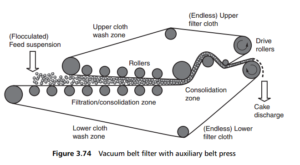0
-
An empty cart
You have no item in your shopping cart
envato-wordpress-toolkit domain was triggered too early. This is usually an indicator for some code in the plugin or theme running too early. Translations should be loaded at the init action or later. Please see Debugging in WordPress for more information. (This message was added in version 6.7.0.) in /var/www/wp-includes/functions.php on line 6121g5plus-darna domain was triggered too early. This is usually an indicator for some code in the plugin or theme running too early. Translations should be loaded at the init action or later. Please see Debugging in WordPress for more information. (This message was added in version 6.7.0.) in /var/www/wp-includes/functions.php on line 6121Belt presses (or press belts or double belt presses as they are equally usefully known), as their name implies, use the pressure of a belt on a mass of wet solids to dewater the solids. They are not filters, because they work by squeezing liquid out of a sludge, but they can be important adjuncts to filters. They work by accepting a reasonably stiff feed suspension onto a continuous lower belt, which carries the wet mass under an upper belt that is pressed down on to the lower one by a series of rollers.
Small belt presses can be used as the final dewatering stage on a vacuum belt filter, or even on a rotary drum filter. When added to a belt filter (as in Figure 3.74), the vacuum dewatered cake is taken by the belt around a series of rollers and squeezed between a subsiding belt acting on top of the cake and a series of taut narrow belts acting on the underside of the main belt, with gaps between them for the liquid to

pass through. The distance between the upper and lower rollers reduces, causing pressure to build up gradually in the cake as it passes over the rollers. The belts move slightly in relation to one another as they pass through the sets of rollers, thus
shearing the cake and releasing more filtrate.
The double belt press is similar in layout to the filter shown in Figure 3.74 , except that the lower belt is impervious. Once the dewatering sludge is caught up between the belts, there is no reason for the belts to be horizontal, so they can be mounted vertically as in the Manor tower press.